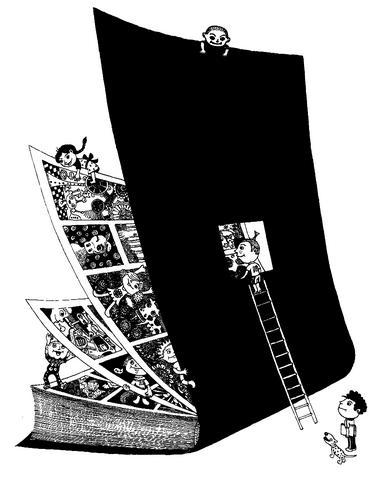The other morning Jens Augner, slight and owlish, a schoolteacher in his 40s, quizzed his eighth-grade class of 13 and 14-year-olds at the Humboldt Gymnasium, a local school. As part of a trial program, he has just introduced a new history textbook into the curriculum: to be exact, a comic book about the Holocaust, called The Search.
Among other things, the book shows how far comics have come as a cultural medium taken seriously here, but also that the Holocaust has come a long way too, as a topic to be freshly considered by a new generation of German teenagers.
As it happens, French President Nicolas Sarkozy just recently made headlines across Europe and elsewhere when, seemingly out of the blue, he announced that beginning next fall, French fifth-graders should each study the life of one of the 11,000 French children killed during the Holocaust. ("Obscene," responded a dumbstruck Pascal Bruckner, the philosopher. He wasn't alone in that sentiment.)

On the new comic book's cover, a teenager named Esther sprints from a truckload of Nazi soldiers. She faces a choice in the book: A policeman will let her flee, if she wants, rather than follow her parents to the camps.
Standing before the blackboard, Augner asked the students what they might have done in Esther's place. Hands shot up.
"Her parents would have wanted her to hide," one girl speculated. A boy pointed out that the policeman, and not only Esther, had to make a difficult decision, because he could have been punished for letting her escape.
Many students said they would have gone after their parents. One declared that she would die for them.
Dying alone
At which point a quiet classmate spoke up: "It's a question of whether you want to die alone."
With World War II passing from living memory, the Holocaust remains a subject taught as a singular event and obligation here, and Germans still seem to grapple almost eagerly with their own historic guilt and shame. That said, few German schoolchildren today can go home to ask their grandparents, much less their parents, what they did while Hitler was around. The end of the war is now as distant from them in time as the end of World War I was from the Reagan presidency.
Paradoxically, this seems to have freed young Germans -- adolescent ones, anyway -- to talk more openly and in new ways about Nazis and the Holocaust. Passing is the shock therapy, with its films of piled corpses, that earlier generations of schoolchildren had to endure.
In the comic Esther recounts to her grandchildren what happened to her family, and in the process facts emerge about Hitler's rise, about deportations and concentration camps. Without excusing anyone or spreading blame, the story, rather than focusing on Hitler and geopolitics, stresses instances where ordinary individuals -- farmers, shopkeepers, soldiers, prison guards, even camp inmates -- faced dilemmas, acted selfishly or ambiguously: showed themselves to be human. The medium's intimacy and immediacy help boil down a vast subject to a few lives that young readers, and older ones too, can grasp.
As for Sarkozy's plan, his education minister suggested that instead of having each school child study a specific Holocaust victim, an entire fifth-grade class might study the life of one child so as not to traumatize every 10-year-old in France. A committee is meeting now to study both proposals. Even if uncooked, the president's original notion about personalizing and revivifying a moral turning point in modern history reflected a broad change afoot.
Ask many Germans now in their 20s, 30s and 40s, and they will describe elementary and high school history classes that virtually cudgeled them into learning about Nazis and the Holocaust. The other morning Jutta Harms recalled her class in a small town in the north of West Germany during the late 1970s. Harms now works for Reprodukt, a leading Berlin publisher of graphic novels.
"Students had to fight to talk freely about the war," she recounted, "and, being confronted in class by the emotions of the teachers, there wasn't any space to feel for ourselves."
The comic book, she went on, is therefore a welcome sign of change.
Their fault
Augner echoed Harms' recollection: "Teachers with good will used to make German children feel it was somehow their fault, that they had a weight on their shoulders. The war was still a fresh wound."
This new comic book, he added, speaks to "a different generation of students."
"It teaches the subject," he continued, "so that it's no longer just about victims and perpetrators."
When a visitor asked Augner's students how much they identified with the Germans who fought the war, they looked blank and slightly baffled.
"It was another generation," one said with a shrug. In that response a page of history seemed to turn.
"The result, I find, is that interest in the subject is actually increasing," Augner said. "These students don't have the same discomfort we did talking about it."
Older Germans can recall a US television miniseries, Holocaust, that shocked people when it was shown here in the late 1970s and helped transform public opinion, giving many permission to break the long silence about Nazi atrocities. It recounted the war from the perspectives of two families, one Jewish, the other Nazi.
The Search takes this approach further, beyond the realm of commercial entertainment and into much subtler territory. The Anna Frank Haus in the Netherlands put it together by joining a team of experts with Eric Heuvel, a Dutch comic artist, whose previous book about the war in the Netherlands was distributed to 200,000 schoolchildren there.
Some 20 classrooms, grades 7 to 10, here in Berlin and in North Rhine-Westphalia, are testing the new book. There are versions in Dutch, German, Hungarian, Polish and English.
"It would not have been possible as a history text 10 years ago, when people here assumed comics were only for those who couldn't read properly," said Harms, from Reprodukt, the comics publisher.
The visual style of The Search is clear, simple, pastel-colored, in a classic Belgian-Franco comic tradition.
"Less is more," Heuvel, the artist, said in a recent telephone conversation, acknowledging that he pilfered liberally from Tintin's creator, Herge. "We spent endless hours making sure that the Nazi costumes were kept to a minimum because boys can glorify these things."
Thomas Heppener, director of the Anne Frank Center in Berlin, said, "There was also a lot of discussion about color."
Black-and-white, he said, is now a cliche of art and movies about the Holocaust. Color is less melodramatic.
"And you know the trees were still green at Auschwitz," he said.
It's a bright autumn day in the book when Esther's parents are rounded up and sent off to die. The comic is more heartbreaking for being understated and cautious about violence.
`No piles of bodies'
Ruud van der Rol, one of the writers, explained: "There are no piles of bodies, because we knew from experience that this could block children from dealing with the whole subject. Also -- and we had endless conversations about this -- we decided not to show Hitler as a beast or inhuman because the Nazis, after all, were human beings. That's the point. Anyone can be a perpetrator or a hero. The choice is yours."
The other afternoon Dilek Geyik, a 30-year-old schoolteacher in training, was preparing to introduce the comic to her students at another Berlin high school. The students there come mostly from working-class families, and from time to time tensions flare between immigrants and right-wing teenagers.
A petite, dark-haired woman, the daughter of Turkish immigrants, Geyik is accustomed to answering the question "Where are you from?" Unlike many of the people who ask, she was born and reared here, a native Berliner. But with a Turkish name, she's simply presumed to be an outsider by many Germans.
"When I was taught about the Holocaust in high school, I felt I could step away from the topic in ways German students couldn't, because it wasn't about me," she said.
"History was something they were supposed to bear in silence. But now you don't have so many witnesses, so the direct connection isn't there for children. And also I came in time to see it myself in a larger context," Geyik said.
"More and more young German students do too. They are sensitive to the idea that the subject is not just about Germans and Jews. It's about people and life," she said.

Taiwan has lost Trump. Or so a former State Department official and lobbyist would have us believe. Writing for online outlet Domino Theory in an article titled “How Taiwan lost Trump,” Christian Whiton provides a litany of reasons that the William Lai (賴清德) and Donald Trump administrations have supposedly fallen out — and it’s all Lai’s fault. Although many of Whiton’s claims are misleading or ill-informed, the article is helpfully, if unintentionally, revealing of a key aspect of the MAGA worldview. Whiton complains of the ruling Democratic Progressive Party’s “inability to understand and relate to the New Right in America.” Many
US lobbyist Christian Whiton has published an update to his article, “How Taiwan Lost Trump,” discussed on the editorial page on Sunday. His new article, titled “What Taiwan Should Do” refers to the three articles published in the Taipei Times, saying that none had offered a solution to the problems he identified. That is fair. The articles pushed back on points Whiton made that were felt partisan, misdirected or uninformed; in this response, he offers solutions of his own. While many are on point and he would find no disagreement here, the nuances of the political and historical complexities in
Taiwan faces an image challenge even among its allies, as it must constantly counter falsehoods and misrepresentations spread by its more powerful neighbor, the People’s Republic of China (PRC). While Taiwan refrains from disparaging its troublesome neighbor to other countries, the PRC is working not only to forge a narrative about itself, its intentions and value to the international community, but is also spreading lies about Taiwan. Governments, parliamentary groups and civil societies worldwide are caught in this narrative tug-of-war, each responding in their own way. National governments have the power to push back against what they know to be
Taiwan is to hold a referendum on Saturday next week to decide whether the Ma-anshan Nuclear Power Plant, which was shut down in May after 40 years of service, should restart operations for as long as another 20 years. The referendum was proposed by the opposition Taiwan People’s Party (TPP) and passed in the legislature with support from the opposition Chinese Nationalist Party (KMT). Its question reads: “Do you agree that the Ma-anshan Nuclear Power Plant should continue operations upon approval by the competent authority and confirmation that there are no safety concerns?” Supporters of the proposal argue that nuclear power